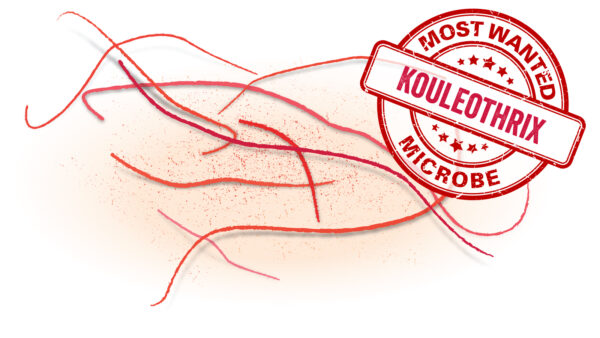From the editor:
This is the second post in an ongoing series profiling microorganisms of particular significance in water and wastewater systems. In this series we will cover microorganisms of many types including some that are beneficial, inhibitory and pathogenic.
Kouleothrix is a filamentous organism found in wastewater treatment systems. They appear as thread-like organisms and can be present as individual filaments or as bundles of multiple filaments. They grow very slowly on R2A agar, taking 6-8 weeks to produce small pink colonies. Kouleothrix is generally characterized by Eikelboom morphotype 1851.
Filamentous organisms have positive and negative effects on wastewater treatment systems. At low abundances, they help with floc formation and aid in settling and pin floc removal. However, at high abundances, filamentous organisms, such as Kouleothrix, cause filamentous bulking which is detrimental to a wastewater treatment system. Filamentous bulking is characterized by poor settling, poor sludge compactability and poor sludge dewatering, all of which culminate in reduced effluent quality and increased chemical (polymer, coagulant, chlorine) usage. Filamentous bulking is traditionally monitored and identified using sludge-volume-index (SVI) measurements or a microscope. Floc-bulking ATP (fbATP) is another method that can detect filamentous bulking. fbATP provides a much more rapid analysis relative to traditional metrics. It also immediately demonstrates the effects of corrective actions, whereas traditional metrics could take several days to see an impact, potentially resulting in unnecessary chemical usage. There is some evidence that Kouleothrix is more prevalent in industrial wastewater systems compared to municipal wastewater systems. The MiDAS: Field Guide to the Microbes of Activated Sludge and Anaerobic Digester reported that Kouleothrix has a 90th percentile relative abundance of 0.6% in 24 Danish activated sludge plants regularly sampled for 16S metagenomics over a five year period.
When a filamentous bulking event is observed there are corrective actions that can be taken to reduce the filamentous population. These include chlorinating the return activated sludge line or temporarily reducing the sludge age to wash the filaments out the system. However, this does not address the root cause of why the abundance of filamentous organisms increased in the first place. Kouleothrix has been attributed to low food-to-microorganism ratios (F:M). F:M is often computed using the mixed-liquor suspended solids (MLSS) concentration to represent the quantity of microorganisms. However, MLSS is comprised of active biomass, dead biomass and non-biological matter. The active biomass fraction can range greatly, making MLSS derived F:M values difficult to interpret. A more representative parameter is active volatile suspended solids (AVSS) which is calculated using 2nd Generation ATP. By using AVSS, a more accurate F:M can be calculated, thereby allowing F:M associated filaments, such as Kouleothrix, to be quickly and accurately diagnosed, permitting corrective actions to be taken sooner.
Further reading:
To learn more about using AVSS operation monitoring tool to track F:M and overall bioreactor health download the Application Note: Biomass Inventory Management Using QG21W.










